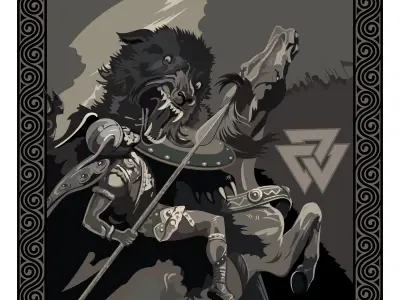Nikki Ella Whitlock was intuitively and subconsciously harnessing sacred geometry in her artwork before she was even aware that this ancient school of thought existed. For an artist whose goal is to make her unconscious conscious and heal through creative practices, her instinctual use of this heartfelt and authentic form of inspiration is hardly surprising.
While Nikki’s experience is unique to her, many of us have an innate awareness of sacred geometry without actually being able to define it. Sacred geometry refers to the naturally occurring shapes and forms that have gone on to inspire some of the finest examples of spiritual art, architecture, symbolism and iconography throughout history.
Geometry alone is simply shapes — squares, circles, triangles — that make up the very building blocks of our entire universe. But when you are able to relate these forms and patterns to deeper meanings or divinity, you are working within the realms of the rules of sacred geometry, manifesting the idea that everything is connected.

For Nikki, the understanding of sacred geometry gained through studies with Centre of Excellence had a particularly profound impact on her life and work. A number of near-death experiences and cosmic happenings have left Nikki with an insatiable art practice through which she tries to make sense of the universe.
She says she’s perpetually “in search of something elusive”.
This is where sacred geometry — the magic of which Nikki has found “hidden in plain sight” — comes into play. “Studying sacred geometry has given me a context and deeper understanding of these experiences,” Nikki says.

She explains that she has “felt these natural rhythms and geometries in [her] body ever since [she] was a child”. Nikki is dyslexic and, like many people who are neurodiverse, she enjoys an advanced visual space and “lives in a very rich and swirling inner world”. She adds, “I also have an inquiring mind and love to take things apart.”
There isn’t much that doesn’t spark Nikki’s creativity and “nothing is off bounds”, she says. But living and working out of her studio in Devon, nature is a vital source of inspiration when creating her rich and opulently textural pieces which are as layered with texture as they are meaning.
A born collector and a former florist, Nikki spends a lot of time gardening and swimming in the sea close to where she lives. It’s a treasure trove of the materials she likes to work with; feathers and beach finds awash with different transparencies, patterns and colours that create beautiful light effects and serendipitous moments in her sculptures.

In life and work, Nikki feels she is on a quest “drawn from my inner world and the oceanic feelings I have in nature” compounded by a sense that she’s on the outside looking in and her occasional disillusionment with society.
Her interests and work often overlap and recurring themes, such as our lost connection with the natural world, are present.
Perhaps it is her profound appreciation of nature, spurred on by her knowledge of sacred geometry, that makes Nikki passionate about creating sustainable work with a focus on environmental issues and healing.

“Everything has potential,” Nikki believes, from discarded objects in junk shops and car boot sales to her old artworks and commissions, which would otherwise be lost to storage.
Nikki’s love of recycling and experimentation has recently led her to repurpose work to create intricate fractal designs on preloved furniture and Art Deco carpet bags; combining form and function while being kind to the world around us.
But sacred geometry is more than a love of nature; it’s not simply reading into the mathematical and spiritual significance of a bee’s repeating honeycomb-patterned home or the Fibonacci curve of a leaf.

It’s also about the connection between these patterns and shapes and how we choose to depict and use them in our everyday lives, connecting us to nature and numbers all at once.
Not one to shy away from manipulating manmade materials into patterns for both practical and spiritual purposes, Nikki also ran a crochet group for many years. Likewise, she appreciates the historical aspect of sacred geometry and the expression of this through architecture.
The artist’s current work — what she calls a cosmic commission — is about rebirthing the Divine Feminine and is full of ancient symbolism. The central figure emanates from a mandorla, an almond shape from the centre of the Vesica Piscis, the first proposition of Euclid’s Elements and the mother of all shapes.

Nikki’s next piece is called Homeostasis and examines “the ability to maintain an internal state, regardless of what's going on in the outside world”. Nikki feels this is key to healing right now, especially given global affairs.
The artwork depicts a goddess and two magpies representing our internal and external dual nature to “give it a sense of harmony and movement” and to counterbalance the conundrum that in stasis we can become stuck.
Nikki is also studying Herbalism, with more courses on her wishlist to complement her art practises. For example, the figure in Homeostasis will be surrounded by healing plants in “an intricate symbiotic symphony between the herbs and our bodies” and the spiritual dimension as conveyed by ancient cultures and shamans.

Nikki also uses poetry, having studied the Poetry Writing Diploma course, alongside preliminary drawings, to work on her large sculptures. She adds, “I love words and sometimes layer them under the art. You can't see them but I know they’re there.”
The daughter of an engineer and a poet, Nikki crosses boundaries between the logical and creative in her work. Mostly self-taught, she studied Art History and Colour Theory as her practice developed in adulthood. But the experience of education in her youth was difficult.
As a mentor to young creatives, she’s seen these patterns repeated with dreams crushed through the academic process, especially for those with special educational needs. Despite seeing many of her mentees thrive against the odds of a system stacked against them, she believes educational reform is necessary. Nikki says, “Even now at 50, if you put me in a classroom environment, my rebel self returns!”
But Nikki found Centre of Excellence courses “easy to follow” and enjoyed learning at her own pace.

This is why eLearning with Centre of Excellence became an “important and valuable” facilitator of Nikki’s work and transformational education in adulthood.
She says, “I find studying alone peaceful. I can hear my thoughts and universal whispers clearly. If, like me, you are a sensitive and creative type, I would suggest studying from home with some small creative interactions. We creative folk sometimes become isolated because we enjoy our own space a little too much.”
However, Nikki says there is still a struggle to put the knowledge and experience of sacred geometry into words and tangible art forms in our three-dimensional world. The artist is hoping to learn skills in augmented reality to bridge the gap.

Ever hopeful and forward-thinking, Nikki has some advice for those looking to make sense of the world through creative expression:
- Use criticisms to your advantage: They are stepping stones on your creative journey to what's really important to you and your practice.
- When you look at others who you admire, ask yourself: How can I improve and grow? What steps do I need to take?
- Take a course, ask for advice, experiment, make a mess!
- Don’t give up. Keep going.
- One last thing: Enjoy yourself and practise, practise, practise.
Nikki herself was told painting is dead at the start of her career by critics who said she was “too crafty” to be a fine artist. They attempted to put her in a box, she recalls.

But she is still determined her fusion art will continue to inspire her to break out, break rules, re-define and defy classification. In Nikki’s words, she learned to alchemise the ‘cannots’ into ‘cans’. Her commissions now sell for thousands. Despite her success, Nikki remains humble, curious, and innovative.
She says, “My greatest achievements have come from my huge failures and I've grown incrementally through these times. I see my art as never-ending or fully complete, I'm always learning and hope to carry on doing so.”
You can enjoy Nikki’s collection of work via her website nikki-ella-whitlock.co.uk.
At the time of publishing, entering the code LEARNING in the checkout will reduce the price of our
Sacred Geometry Diploma Course to £29.





